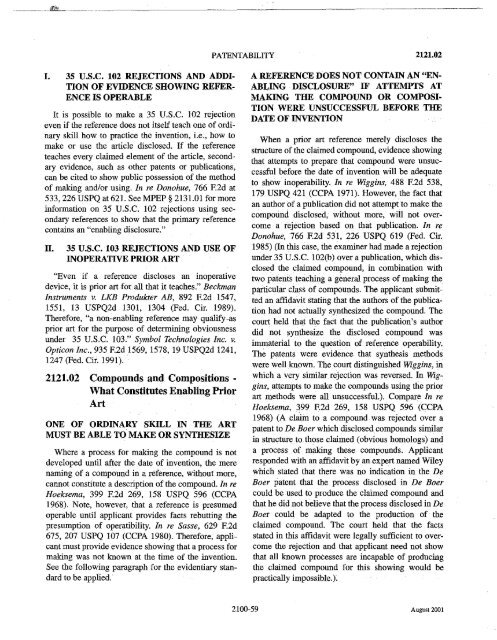The Subject Patent Already Has Underlining or ... - Bayhdolecentral
The Subject Patent Already Has Underlining or ... - Bayhdolecentral
The Subject Patent Already Has Underlining or ... - Bayhdolecentral
You also want an ePaper? Increase the reach of your titles
YUMPU automatically turns print PDFs into web optimized ePapers that Google loves.
I. 35 U.S.C. 102 REJECTIONS AND ADDI<br />
TION OF EVIDENCE SHOWING REFER<br />
ENCE IS OPERABLE<br />
It is possible to make a 35 U.S.C. 102 rejection<br />
even if the reference does not itself teach one of <strong>or</strong>dinary<br />
skill how to practice the invention, i.e., how to<br />
make <strong>or</strong> use the article disclosed. If the reference<br />
teaches every claimed element of the article, secondary<br />
evidence, such as other patents <strong>or</strong> publications,<br />
can be cited to show public possession of the method<br />
of making and/<strong>or</strong> using. In re Donohue, 766 F.2d at<br />
533,226 USPQ at 621. See MPEP § 2131.01 f<strong>or</strong> m<strong>or</strong>e<br />
inf<strong>or</strong>mation on 35 U.S.C. 102 rejections using secondary<br />
references to show that the primary reference<br />
contains an "enabling disclosure."<br />
II. 35 U.S.C. 103 REJECTIONS AND USE OF<br />
INOPERATIVE PRIOR ART<br />
"Even if a reference discloses an inoperative<br />
device, it is pri<strong>or</strong> art f<strong>or</strong> all that it teaches." Beckman<br />
Instruments v. LKB Produkter AB, 892 F.2d 1547,<br />
1551, 13 USPQ2d 1301, 1304 (Fed. Cir. 1989).<br />
<strong>The</strong>ref<strong>or</strong>e, "a non-enabling reference may qualify-as<br />
pri<strong>or</strong> art f<strong>or</strong> the purpose of determining obviousness<br />
under 35 U.S.C. 103." Symbol Technologies Inc. v.<br />
Opticon Inc., 935 F.2d 1569, 1578, 19 USPQ2d 1241,<br />
1247 (Fed. Cir. 1991).<br />
2121.02 Compounds and Compositions <br />
What Constitutes Enabling Pri<strong>or</strong><br />
Art<br />
ONE OF ORDINARY SKILL IN THE ART<br />
MUST BE ABLE TO MAKE OR SYNTHESIZE<br />
Where a process f<strong>or</strong> making the compound is not<br />
developed until after the date of invention, the mere<br />
naming of a compound in a reference, without m<strong>or</strong>e,<br />
cannot constitute a description of the compound. In re<br />
Hoeksema, 399 F.2d 269, 158 USPQ 596 (CCPA<br />
1968). Note, however, that a reference is presumed<br />
operable until applicaut provides facts rebutting the<br />
presumption of operatibility. In re Sasse, 629 F.2d<br />
675, 207 USPQ 107 (CCPA 1980). <strong>The</strong>ref<strong>or</strong>e, applicant<br />
must provide evidence showing that a process f<strong>or</strong><br />
making was not known at the time of the invention.<br />
See the following paragraph f<strong>or</strong> the evidentiary standard<br />
to be applied.<br />
PATENTABILITY<br />
2121.02<br />
A REFERENCE DOES NOT CONTAIN AN "EN<br />
ABLING DISCLOSURE" IF ATTEMPTS AT<br />
MAKING THE COMPOUND OR COMPOSI<br />
TION WERE UNSUCCESSFUL BEFORE THE<br />
DATE OF INVENTION<br />
When a pri<strong>or</strong> art reference merely discloses the<br />
structure of the claimed compound, evidence showing<br />
that attempts to prepare that compound were unsuccessful<br />
bef<strong>or</strong>e the date of invention will be adequate<br />
to show inoperability. In re Wiggins, 488 F.2d 538,<br />
179 USPQ 421 (CCPA 1971). However, the fact that<br />
an auth<strong>or</strong> of a publication did not attempt to make the<br />
compound disclosed, without m<strong>or</strong>e, will not overcome<br />
a rejection based on that publication. In re<br />
Donohue, 766 F.2d 531, 226 USPQ 619 (Fed. Cir.<br />
1985) (In this case, the examiner had made a rejection<br />
under 35 U.S.C. 102(b) over a publication, which disclosed<br />
the claimed compound, in combination with<br />
two patents teaching a general process of making the<br />
particular class of compounds. <strong>The</strong> applicant submitted<br />
an affidavit stating that the auth<strong>or</strong>s of the publication<br />
had not actually synthesized the compound. <strong>The</strong><br />
court held that the fact that the publication's auth<strong>or</strong><br />
did not synthesize the disclosed compound was<br />
immaterial to the question of reference operability.<br />
<strong>The</strong> patents were evidence that synthesis methods<br />
were wellknown. <strong>The</strong> court distinguished Wiggins, iu<br />
which a very similar rejection was reversed. II1 Wiggins,<br />
attempts to make the compounds using the pri<strong>or</strong><br />
art methods were all unsuccessful.). Compare In re<br />
Hoeksema, 399 F.2d 269, 158 USPQ 596 (CCPA<br />
1968) (A claim to a compound was rejected over a<br />
patent to De Boer which disclosed compounds similar<br />
iu sttucture to those claimed (obvious homologs) and<br />
a process of making these compounds. Applicant<br />
responded with an affidavit by an expert named Wiley<br />
which stated that there was uo indication in the De<br />
Boer patent that the process disclosed in De Boer<br />
could be used to produce the claimed compound and<br />
that he did not believe that the process disclosed in De<br />
Boer could be adapted to the production of the<br />
claimed compound. <strong>The</strong> court held that the facts<br />
stated in this affidavit were legally sufficient to overcome<br />
the rejection and that applicant need not show<br />
that all known processes are incapable of producing<br />
the claimed compound f<strong>or</strong> this showing would be<br />
practically impossible.),<br />
2100-59 August 2001

















